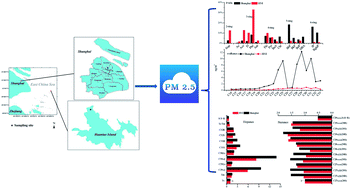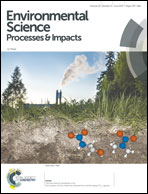Comparison of PM2.5 carbonaceous pollutants between an urban site in Shanghai and a background site in a coastal East China Sea island in summer: concentration, composition and sources†
Abstract
Nine paired samples of atmospheric particulate matter with an aerodynamic diameter less than or equal to 2.5 μm (PM2.5) were collected concurrently from an urban site in Shanghai, China and a background site in Huaniao Island (HNI) in the coastal East China Sea (ECS) between July 21 and 29, 2011. The samples were analyzed for 16 United States Environmental Protection Agency (USEPA) priority polycyclic aromatic hydrocarbons (PAHs), n-alkanes (20 species, C14–C33), hopanes (10 species, C29–C32), and steranes (12 species, C27–C29). These two sites, approximately 66 km apart, are both on the pathway of land-based pollutants as they are transported to the ECS by seasonal winds. As expected, concentrations in Shanghai were higher (average: 8.4 and 67.8 ng m−3 for the 16 PAHs and n-alkanes, respectively) than those in HNI (average: 1.8 and 8.5 ng m−3, respectively). The dominant contributor to the 16 PAHs in Shanghai was 5–6-ring PAHs (60.0%), whereas 2–3-ring PAHs contributed the most (72.5%) in HNI. Plant waxes contributed 45.7% and 25.9% of the n-alkanes in Shanghai and HNI, respectively, implying a relatively greater contribution from petroleum residues to the n-alkanes in HNI. Principal component analysis (PCA) and the compositions of hopanes and steranes highlighted a prominent contribution from traffic emissions to carbonaceous PM2.5 aerosols. This study provides comprehensive details about the sources, formation, and transport of pollutants from eastern China to the coastal ECS.



 Please wait while we load your content...
Please wait while we load your content...